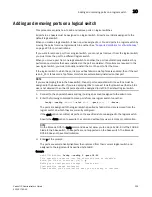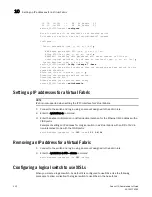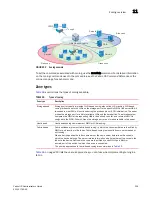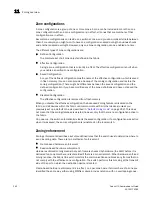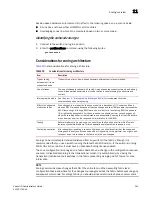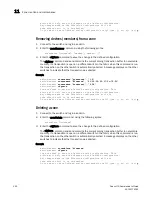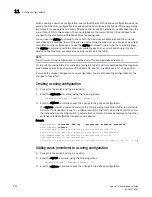
240
Fabric OS Administrator’s Guide
53-1001763-02
Zoning overview
11
Zone objects
A
zone object
is any device in a zone, such as:
•
Physical port number or port index on the switch
•
Node World Wide Name (N-WWN)
•
Port World Wide Name (P-WWN)
Zone objects identified by port number or index number are specified as a pair of decimal numbers
in the form
D,I
, where
D
is the domain ID of the switch and
I
is the index number on that switch in
relation to the port you want to specify.
TABLE 49
Approaches to fabric-based zoning
Zoning approach
Description
Recommended approach
Single HBA
Zoning by single HBA most closely re-creates the original SCSI bus. Each zone created has only
one HBA (initiator) in the zone; each of the target devices is added to the zone. Typically, a zone
is created for the HBA and the disk storage ports are added. If the HBA also accesses tape
devices, a second zone is created with the HBA and associated tape devices in it. In the case of
clustered systems, it could be appropriate to have an HBA from each of the cluster members
included in the zone; this is equivalent to having a shared SCSI bus between the cluster
members and assumes that the clustering software can manage access to the shared devices.
In a large fabric, zoning by single HBA requires the creation of possibly hundreds of zones;
however, each zone contains only a few members. Zone changes affect the smallest possible
number of devices, minimizing the impact of an incorrect zone change. This zoning philosophy
is the preferred method.
Alternative approaches
Application
Zoning by application typically requires zoning multiple, perhaps incompatible, operating
systems into the same zones. This method of zoning creates the possibility that a minor server
in the application suite could disrupt a major server (such as a Web server disrupting a data
warehouse server). Zoning by application can also result in a zone with a large number of
members, meaning that more notifications, such as registered state change notifications
(RSCNs), or errors, go out to a larger group than necessary.
Operating
system
Zoning by operating system has issues similar to zoning by application. In a large site, this type
of zone can become very large and complex. When zone changes are made, they typically
involve applications rather than a particular server type. If members of different operating
system clusters can see storage assigned to another cluster, they might attempt to own the
other cluster’s storage and compromise the stability of the clusters.
Port allocation
Avoid zoning by port allocation unless the administration team has very rigidly enforced
processes for port and device allocation in the fabric. It does, however, provide some positive
features. For instance, when a storage port, server HBA, or tape drive is replaced, the change of
WWN for the new device is of no consequence. As long as the new device is connected to the
original port, it continues to have the same access rights. The ports on the edge switches can
be pre-associated to storage ports, and control of the fan-in ratio (the ratio of the input port to
output port) can be established. With this pre-assigning technique, the administrative team
cannot overload any one storage port by associating too many servers with it.
Not recommended
No fabric zoning Using no fabric zoning is the least desirable zoning option because it allows devices to have
unrestricted access on the fabric. Additionally, any device attached to the fabric, intentionally or
maliciously, likewise has unrestricted access to the fabric. This form of zoning should be utilized
only in a small and tightly controlled environment, such as when host-based zoning or LUN
masking is deployed.
Содержание 53-1001763-02
Страница 1: ...53 1001763 02 13 September 2010 Fabric OS Administrator s Guide Supporting Fabric OS v6 4 0 ...
Страница 4: ...iv Fabric OS Administrator s Guide 53 1001763 02 ...
Страница 24: ...xxiv Fabric OS Administrator s Guide 53 1001763 02 ...
Страница 28: ...xxviii Fabric OS Administrator s Guide 53 1001763 02 ...
Страница 32: ...xxxii Fabric OS Administrator s Guide 53 1001763 02 ...
Страница 40: ...xl Fabric OS Administrator s Guide 53 1001763 02 ...
Страница 42: ...2 Fabric OS Administrator s Guide 53 1001763 02 ...
Страница 54: ...14 Fabric OS Administrator s Guide 53 1001763 02 High availability of daemon processes 1 ...
Страница 74: ...34 Fabric OS Administrator s Guide 53 1001763 02 Basic connections 2 ...
Страница 102: ...62 Fabric OS Administrator s Guide 53 1001763 02 Audit log configuration 3 ...
Страница 156: ...116 Fabric OS Administrator s Guide 53 1001763 02 The authentication model using RADIUS and LDAP 5 ...
Страница 214: ...174 Fabric OS Administrator s Guide 53 1001763 02 Management interface security 7 ...
Страница 228: ...188 Fabric OS Administrator s Guide 53 1001763 02 Brocade configuration form 8 ...
Страница 276: ...236 Fabric OS Administrator s Guide 53 1001763 02 Creating a logical fabric using XISLs 10 ...
Страница 404: ...364 Fabric OS Administrator s Guide 53 1001763 02 ...
Страница 440: ...400 Fabric OS Administrator s Guide 53 1001763 02 Performance data collection 17 ...
Страница 464: ...424 Fabric OS Administrator s Guide 53 1001763 02 Disabling bottleneck detection on a switch 18 ...
Страница 480: ...440 Fabric OS Administrator s Guide 53 1001763 02 F_Port masterless trunking 19 ...
Страница 494: ...454 Fabric OS Administrator s Guide 53 1001763 02 Buffer credit recovery 20 ...
Страница 560: ...520 Fabric OS Administrator s Guide 53 1001763 02 Port indexing on the Brocade DCX 4S backbone C ...
Страница 574: ...534 Fabric OS Administrator s Guide 53 1001763 02 Hexadecimal overview E ...




